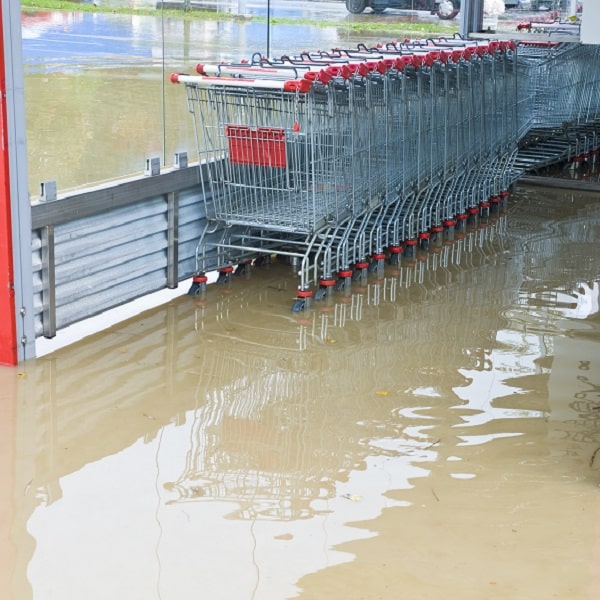
Commercial Cleaning Tools for Flood Damage Cleanup
Flood damage from natural causes continues to increase in the United States, despite extensive flood management efforts. Combine that threat with unpredictable events, such as broken waterlines, and facilities must be prepared to manage flood cleanup and repair at any given point in time. There are numerous steps to the flood damage cleanup and restoration process, but the commercial grade tools you source will go a long way in helping you move to the next steps faster and safer, and ultimately, successfully re-open your facility.
The Basics of Safe Flood Damage Clean Up
In additional to taking personal safety precautions (like wearing appropriate protective gear) to keep cleaning staff safe from germs in the water, mold on surfaces and the chemicals in cleaning supplies, facilities should also start the process by:
- Opening windows and using fans to pull any fumes away from the flood damaged area
- Avoiding dry sweeping to limit potentially hazardous dust spread
- Using commercial cleaning solutions that use a disinfectant for killing germs
- Sourcing flood cleanup equipment that effectively cleans before disinfecting and keeps staff at a safe distance from contaminants
Water Removal
In any circumstance, standing water can quickly become a breeding ground for bacteria and mold. To avoid spread, water needs to be cleaned up quickly and effectively, laying the groundwork for more effective disinfecting to follow. Depending on the level of flooding, you can use pails or pumps, a wet/dry shop vacuum, or commercial grade, heavy duty floor squeegees, which are ideal for removing large volumes of water and debris, including asphalt, tile, concrete and linoleum.
The type of floor will dictate which type of squeegee is best for your water removal and flood cleanup needs. A foam squeegee is best for tile and asphalt floors, while smooth floors, such as concrete and asphalt, require a rubber bladed squeegee for optimal performance. In addition to the type of squeegee material, squeegees can also be straight or curved. Straight squeegees are better for moving large volumes of water and debris; curved squeegees are better for moving substances in a specific direction, such as towards a drain.
Once the right floor squeegee is selected for the job, you can begin the water removal process. The most effective method of removing water and debris is to pull, not push, the squeegee. Start at the edge, moving the liquid and debris towards a drain or other area of disposal. Continually tap the squeegee to remove excess liquid or dirt.
Once the water and debris are removed, the floor squeegee can continue working in the floor cleaning and disinfecting process. The squeegee can be used to spread the disinfecting solution on the floor to sanitize the surface. If there was mold growth on the floor surface, you may need to enlist the help of a heavy duty floor brush to scrub the floor clean.
Litter and Debris Removal
When removing debris during flood damage cleanup, expect all debris to be contaminated! Wearing gloves is not sufficient to protect yourself: employing litter removal tools is effective for retrieving objects that could potentially harbor dangerous germs or contaminants. A hygienic all-purpose grabber that keeps hands away from debris with an extended, long handle will allow you to clean up safer.
Cleaning Walls and Surfaces
Walls must dry from the inside out after being exposed to flood water, meaning the interior framing of walls must be thoroughly dried as well as the outside wall material. With proper cleaning and disinfection, it may be possible to salvage the wall finishes.
Basic steps to cleaning walls after a flood include:
- Remove paneling after flood
- Release water and mud from inside the walls by removing and discarding interior finishes and insulation. Remove any part where you see or feel moisture.
- Hose down walls before they dry completely
- Rinse walls several times
- Clean and disinfect them
With proper cleaning and disinfecting, it may be possible to salvage what’s left behind, including not just walls, but also other surfaces within a facility. Tools like Unger’s patented Stingray surface cleaning tool allows you to easily clean walls and surfaces with the added benefit of touch free cleaning. Tools like the Stingray that feature a telescopic pole to hold the cleaning pad help keep hands at a safe distance from surface contaminants as you work your way up the flood damaged areas.
Sourcing Cleaning Tools for Flood Damage Cleanup
Find all the commercial cleaning tools you need for efficient flood damage cleanup and water removal on all your floors and surfaces. With our ergonomically designed cleaning tools, you’ll be able to quickly and effectively get your facility operating back to business as usual.
